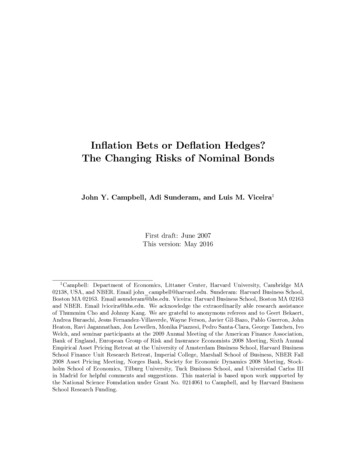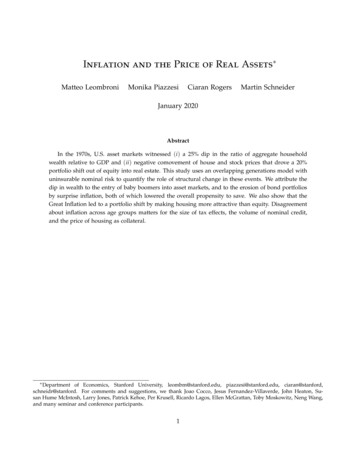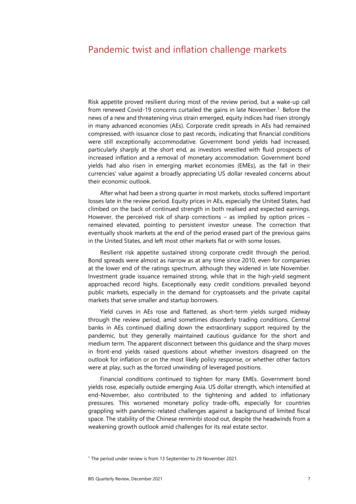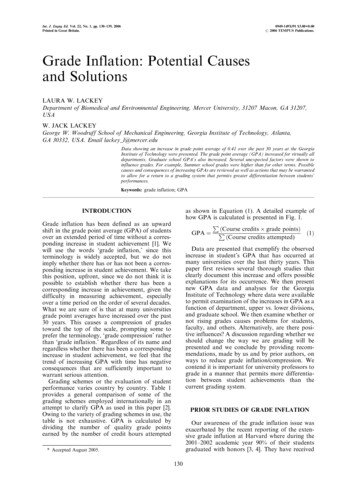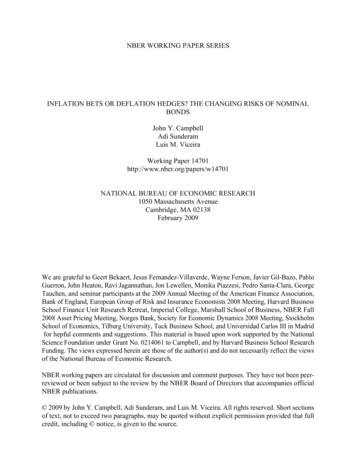
Transcription
NBER WORKING PAPER SERIESINFLATION BETS OR DEFLATION HEDGES? THE CHANGING RISKS OF NOMINALBONDSJohn Y. CampbellAdi SunderamLuis M. ViceiraWorking Paper 14701http://www.nber.org/papers/w14701NATIONAL BUREAU OF ECONOMIC RESEARCH1050 Massachusetts AvenueCambridge, MA 02138February 2009We are grateful to Geert Bekaert, Jesus Fernandez-Villaverde, Wayne Ferson, Javier Gil-Bazo, PabloGuerron, John Heaton, Ravi Jagannathan, Jon Lewellen, Monika Piazzesi, Pedro Santa-Clara, GeorgeTauchen, and seminar participants at the 2009 Annual Meeting of the American Finance Association,Bank of England, European Group of Risk and Insurance Economists 2008 Meeting, Harvard BusinessSchool Finance Unit Research Retreat, Imperial College, Marshall School of Business, NBER Fall2008 Asset Pricing Meeting, Norges Bank, Society for Economic Dynamics 2008 Meeting, StockholmSchool of Economics, Tilburg University, Tuck Business School, and Universidad Carlos III in Madridfor hepful comments and suggestions. This material is based upon work supported by the NationalScience Foundation under Grant No. 0214061 to Campbell, and by Harvard Business School ResearchFunding. The views expressed herein are those of the author(s) and do not necessarily reflect the viewsof the National Bureau of Economic Research.NBER working papers are circulated for discussion and comment purposes. They have not been peerreviewed or been subject to the review by the NBER Board of Directors that accompanies officialNBER publications. 2009 by John Y. Campbell, Adi Sunderam, and Luis M. Viceira. All rights reserved. Short sectionsof text, not to exceed two paragraphs, may be quoted without explicit permission provided that fullcredit, including notice, is given to the source.
Inflation Bets or Deflation Hedges? The Changing Risks of Nominal BondsJohn Y. Campbell, Adi Sunderam, and Luis M. ViceiraNBER Working Paper No. 14701February 2009, Revised July 2013JEL No. G0,G10,G11,G12ABSTRACTThe covariance between US Treasury bond returns and stock returns has moved considerably overtime. While it was slightly positive on average in the period 1953-2009, it was unusually high inthe early 1980's and negative in the early 2000's, partucularly in the downturns of 2000-02 and 2007-09.This paper specifies and estimates a model in which the nominal term structure of interest rates is drivenby four state variables: the real interest rate, temporary and permanent components of expectedinflation, and the "nominal-real covariance" of inflation and the real interest rate with the realeconomy. The last of these state variables enables the model to fit the changing covariance of bond andstock returns. Log bond yields and term premia are quadratic in these state variables, with term premiadetermined by the nominal-real covariance. The concavity of the yield curve -- the level ofintermediate-term bond yields, relative to the average of short- and long-term bond yields -- is a goodproxy for the level of term premia. The nominal-real covariance has declined since the early 1980's,driving down term premia.John Y. CampbellMorton L. and Carole S.Olshan Professor of EconomicsDepartment of EconomicsHarvard UniversityLittauer Center 213Cambridge, MA 02138and NBERjohn campbell@harvard.eduAdi Sunderam420M Baker LibraryHarvard Business SchoolBoston, MA 02163sunderam@fas.harvard.eduLuis M. ViceiraGeorge E. Bates ProfessorHarvard Business SchoolBaker Library 367Boston, MA 02163and NBERlviceira@hbs.edu
1IntroductionIn recent years investors have come to regard US Treasury bonds as hedges, assets that perform well when other assets lose value, and more generally when badmacroeconomic news arrives. During both of the two most recent stock market andmacroeconomic downturns, in 2000–02 and 2007–09, Treasury bonds performed well.In addition, for the past decade and particularly during these downturns, Treasurybond returns have been negatively correlated with stock returns at a daily frequency.In previous decades, however, Treasury bonds performed very di erently; they wereeither uncorrelated or positively correlated with stock returns. The purpose of thispaper is to highlight these changes in magnitude and switches in sign of the covariation between bonds and stocks, and to ask what they imply for bond risk premia andthe shape of the term structure of interest rates.To understand how a changing bond-stock covariance can a ect the pricing ofTreasury bonds, we specify and estimate a multifactor term structure model thatincorporates traditional macroeconomic in‡uences— real interest rates and expectedin‡ation— along with a state variable driving the variance of real and nominal interestrates and their covariance with the macroeconomy. The model is set up so that allfactors have an economic interpretation, and the covariance of bond returns with themacroeconomy can switch sign. For simplicity, the basic version of the model assumesa constant price of risk, or equivalently, a constant variance for the stochastic discountfactor. We estimate the model using postwar quarterly US time series for nominaland in‡ation-indexed bond yields, stock returns, realized and forecast in‡ation, andthe realized second moments of bond and stock returns calculated from daily datawithin each quarter. The use of realized second moments, unusual in the termstructure literature, forces our model to t the historically observed changes in risks.Our model delivers three main results. First, the risk premia of nominal Treasurybonds should have changed over the decades because of changes in the covariance between in‡ation and the real economy. The model predicts positive nominal bondrisk premia in the early 1980s, when bonds covaried positively with stocks, and negative risk premia in the 2000s and particularly during the downturn of 2007–09, whenbonds hedged equity risk.Second, a strongly concave term structure of interest rates, with high interestrates at a maturity around 3 years relative to short- and long-term interest rates,should predict high excess bond returns. In the model, a high bond-stock covariance1
is associated with a high volatility of bond returns. The high bond-stock covariancegenerates a high term premium and a steep yield curve at maturities of 1-3 years,while the high bond volatility lowers long-term yields through a Jensen’s inequalityor convexity e ect. Thus, the concavity of the yield curve is a good proxy for thebond-stock covariance. In this fashion, our model explains the qualitative nding ofCochrane and Piazzesi (2005) that a tent-shaped linear combination of forward rates,with a peak at about 3 years, predicts excess bond returns at all maturities.Third, however, our model does not explain the volatility of term premia implied by predictive regressions of excess bond returns onto bond yields. Whetherthese regressions use maturity-matched yield spreads (Campbell and Shiller 1991),maturity-matched forward spreads (Fama and Bliss 1987), or a multi-maturity combination of forward rates (Cochrane and Piazzesi 2005), they imply much greatervariability of expected excess bond returns than is captured by our model. Thisnegative nding implies that bond risk premia respond to other factors besides thebond-stock covariance. It is an open question whether these factors are best modeledusing an exogenously changing price of risk, as in the literature on essentially a nebond pricing models following Du ee (2002), or whether other variables such as thesupply of Treasury bonds need to be incorporated into the analysis as advocated byGreenwood and Vayanos (2012) and Krishnamurthy and Vissing-Jorgensen (2012).To illustrate the basic observation that motivates this paper, Figure 1 plots thehistory of the realized covariance of 10-year nominal zero-coupon Treasury bonds withthe CRSP value-weighted stock index, calculated using a rolling three-month windowof daily data. For ease of interpretation, the gure also shows the history of therealized beta of Treasury bonds with stocks (the bond-stock covariance divided bythe realized variance of stock returns), as this allows a simple back-of-the-envelopecalculation of the term premium that would be implied by the simple Capital AssetPricing Model (CAPM) given any value for the equity premium. The covariance(plotted on the left vertical scale) and beta (on the right vertical scale) move closelytogether, with the major divergences occurring during periods of low stock returnvolatility in the late 1960s and the mid-1990s.Figure 1 displays a great deal of high-frequency variation in both series, muchof which is attributable to noise in realized second moments. But it also showssubstantial low-frequency movements. The beta of bonds with stocks was close tozero in the mid-1960’s and mid-1970’s, much higher with an average around 0.4 inthe 1980’s, spiked in the mid-1990’s, and declined to negative average values in the2
2000’s. During the two downturns of 2000–02 and 2007–09, the average realized betaof Treasury bonds was about -0.2. Thus from peak to trough, the realized beta ofTreasury bonds has declined by about 0.6 and has changed its sign. According to theCAPM, this would imply that term premia on 10-year zero-coupon Treasuries shouldhave declined by 60% of the equity premium.Nominal bond returns respond both to expected in‡ation and to real interestrates. A natural question is whether the pattern shown in Figure 1 re‡ects a changingcovariance of in‡ation with the stock market, or a changing covariance of real interestrates with the stock market. Figure 2 plots the covariance and beta of in‡ation shockswith stock returns, using a rolling three-year window of quarterly data and a rstorder quarterly vector autoregression for in‡ation, stock returns, and the three-monthTreasury bill yield to calculate in‡ation shocks. Because high in‡ation is associatedwith high bond yields and low bond returns, the gure shows the covariance and betafor realized de‡ation shocks (the negative of in‡ation shocks) which should move in thesame manner as the bond return covariance and beta reported in Figure 1. Indeed,Figure 2 shows a similar history for the de‡ation covariance as for the nominal bondcovariance.Real interest rates also play a role in changing nominal bond risks. In the periodsince 1997, when long-term Treasury in‡ation-protected securities (TIPS) were rstissued, Campbell, Shiller, and Viceira (2009) report that TIPS have had a predominantly negative beta with stocks. Like the nominal bond beta, the TIPS beta wasparticularly negative in the downturns of 2000–02 and 2007–09. Thus not only thestock-market covariances of nominal bond returns, but also the covariances of twoproximate drivers of those returns, in‡ation and real interest rates, change over timeand occasionally switch sign. We design our term structure model to t these facts.The organization of the paper is as follows. Section 2 brie‡y reviews the relatedliterature. Section 3 presents our model of the real and nominal term structures ofinterest rates. Section 4 describes our estimation method and presents parameterestimates and historical tted values for the unobservable state variables of the model.Section 5 discusses the implications of the model for the shape of the yield curve andthe movements of risk premia on nominal bonds. Section 6 concludes. An Appendixto this paper available online (Campbell, Sunderam, and Viceira 2013) presents detailsof the model solution and additional empirical results.3
2Literature ReviewDespite the striking movements in the bond-stock covariance illustrated in Figure 1,this second moment has received relatively little attention in the enormous literatureon the term structure of interest rates.2 One reason for this neglect may be thatuntil the last 15 years, the covariance was almost always positive and thus it wasnot apparent that it could switch sign. In the absence of a sign switch, a modelof changing bond market volatility, with a constant correlation or even a constantcovariance between bonds and stocks, might be adequate.The early literature on the term structure of interest rates concentrated on testingthe null hypothesis of constant bond risk premia, also known as the expectationshypothesis of the term structure (Shiller, Campbell, and Schoenholtz 1983, Famaand Bliss 1987, Stambaugh 1988, Campbell and Shiller 1991). Second-generationa ne term structure models such as Cox, Ingersoll, and Ross (1985) modeled changesin bond market volatility linked to the short-term interest rate. This approachencounters the di culty that bond market volatility appears to move independentlyof the level of interest rates. In addition, the empirical link between bond marketvolatility and the expected excess bond return is weak, although some authors suchas Campbell (1987) do estimate it to be positive.3In the last ten years a large literature has speci ed and estimated essentiallya ne term structure models (Du ee 2002), in which a changing price of risk cana ect bond market risk premia without any change in the quantity of risk, whilerisk premia are linear functions of bond yields (Dai and Singleton 2002, Sangvinatsosand Wachter 2005, Wachter 2006, Buraschi and Jiltsov 2007, Bekaert, Engstrom, andXing 2009, Bekaert, Engstrom, and Grenadier 2010). Models such as those of Daiand Singleton (2002) and Sangvinatsos and Wachter (2005) achieve a good t tothe historical term structure, but this literature uses latent factors that are hard tointerpret economically.2Important exceptions in the last decade include Li (2002), Guidolin and Timmermann (2006),Christiansen and Ranaldo (2007), David and Veronesi (2009), Baele, Bekaert, and Inghelbrecht(2010), and Viceira (2012).3More recently, Piazzesi and Schneider (2006) and Rudebusch and Wu (2007) have built a nemodels of the nominal term structure in which a reduction of in‡ation uncertainty drives down therisk premia on nominal bonds towards the lower risk premia
Like the nominal bond beta, the TIPS beta was particularly negative in the downturns of 2000Œ02 and 2007Œ09. Thus not only the stock-market covariances of nominal bond returns, but also the covariances of two proximate drivers of those returns, in ation and real interest rates, change over time and occasionally switch sign. We design our term structure model to –t these facts.Cited by: 115Publish Year: 2017Author: John Y. Campbell, Adi Sunderam, Luis M. Viceira
